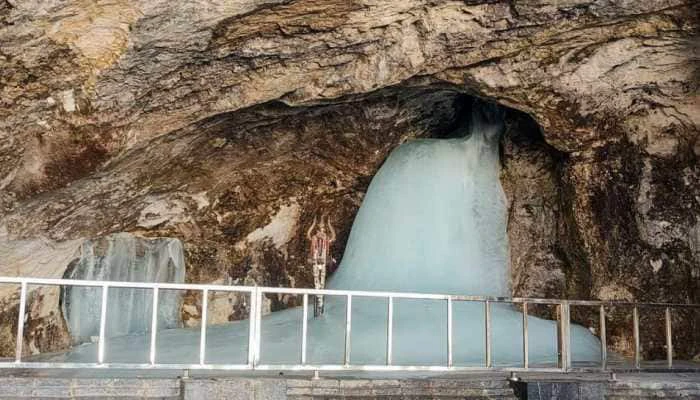A massive heatwave in Kashmir has affected the annual Amarnath Yatra, causing the rapid melting of the naturally formed ice Shivling, the symbol of Lord Shiva, within the first 10 days of the pilgrimage.
The early melting of the ice Shivling at the Amarnath cave shrine this year is attributed to a severe heatwave in Kashmir. It has significantly impacted the annual Amarnath Yatra.
Devotees who returned from the holy cave to Srinagar today said that the naturally formed ice Shivling, a sacred symbol of Lord Shiva, has almost completely melted. Its only been 10 days since the Yatra began on July 3. Reports indicate that the Shivling, which historically stood 12 to 15 feet tall, has been reduced to just a few inches. Only the base of the ice formation, believed to represent Lord Shivas feet, remains in the holy cave. This marks one of the fastest melting events in the recent history of the Amarnath Yatra.
Despite the Shivlings absence, over 1.70 lakh pilgrims had visited the 3,880-meter-high holy cave in Anantnag district by July 12. With 26 days still left in the pilgrimage, the melting of the Shivling has not affected the faith of Lord Shivas devotees. While acknowledging that the Shivling has melted, devotees continue their pilgrimage, emphasizing their spiritual devotion to the holy cave. Chanting Har Har Mahadev and Bam Bam Bhole, thousands are still trekking to the holy cave and completing their pilgrimage.
Jitendra Ghalot from Rajasthan said, My journey started on the 5th, and we reached Baltal on the 7th. On the second day, we had Babas darshan. The facilities are very good, and security is very high. The Shivling size is very small. I tell pilgrims they should still go, as the holy cave itself resembles Lord Shiva. We are not disappointedthere is great spiritual value in the cave.
Satish Kumar said, We did darshan on July 9. Its my second time, and this time the facilities are much better. The Shivling has melted, but we came with faith, and we are satisfied. People should come and do darshan of the place of Lord Shiva. We were told that the Shivling is melting, but we still came.
Satish Kathuriya said, We did darshan yesterday. Lord Shiva is present in everything. Even if the Shivling is not there, Lord Shivas feet are still visible.
The Shivlings duration has been shrinking over the years, reflecting the impacts of regional climate change. In 2022, it lasted 28 days. In 2023, it melted in 22 days. In 2024, it lasted only 16 days. Now, in 2025, it has melted within the first 10 days of the Yatras start.
Weather experts from Kashmir said that glaciers near the Amarnath cave are retreating, and there has been no systematic research since the 1980s to assess their response to climate change. The regions glaciers, including five near the cave, are shrinking in mass and area. This impacts water availability, and the lack of snowfall and rising temperatures are key contributors to the Shivlings rapid melting.
Moreover, when the pilgrimage begins, massive human activity adds to the local temperature, further accelerating the melting of the ice-formed Shivling. This year, the Kashmir Valley has witnessed unusual weather. A 6070% deficit in rainfall and snowfall has been recorded in both summer and winter. Temperatures have broken past records, with Srinagar recording a high of 37.4Cthe highest since 1953.
The heatwave of 2025, combined with minimal snow cover on pilgrimage routes, has led to dry and dusty conditions, a stark contrast to the glacier-laden paths of earlier years. Experts attribute this to broader climate change trends, with regional temperatures rising significantly since May. Climate experts say temperatures have been continuously increasing over the last 10 years and are expected to rise further due to global warming, which has severely impacted Himalayan glaciers.
A weather expert from Kashmir said, We saw very high temperatures this yearhigher than those in 1953. This was the hottest June and July in Kashmir. Even now, temperatures are above normal. Precipitation has been very low. Glaciers are melting, and water levels in rivers like the Jhelum are very low. Reports are coming in about the Shivling meltingits a direct effect of global warming. Temperatures have been rising for the last ten years and will continue to increase.
Officials have also stopped predicting the Shivlings duration in recent years due to unpredictable weather patterns, choosing instead to focus on improving facilities such as routes and camps.
The premature melting of the Shivling is now seen as a barometer of climate distress in the Kashmir Himalayas. Experts are calling for formal research to better understand glacier melt and its long-term impacts.
Let me know if you’d like a summary version or visual infographic ideas for this.
